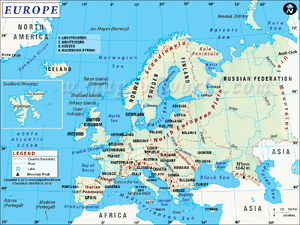Luxembourg
| Author:Laxman Burdak, IFS (R) |


Luxembourg (लक्षमबर्ग) is a landlocked country in Western Europe.
Location
It is bordered by Belgium to the west and north, Germany to the east, and France to the south. It comprises two principal regions: the Oesling in the north as part of the Ardennes massif, and the Gutland ("good country") in the south.
Origin
History
What is present-day Luxembourg was inhabited by Celts during the Iron Age (from roughly 600 BC until 100 AD). The Gaulish tribe in what is present-day Luxembourg during and after the La Tène period was known as the Treveri, which reached the height of prosperity in the 1st century BC. They constructed a number of fortified settlements or oppida near the Moselle valley in what is now southern Luxembourg, western Germany and eastern France. Most of the archaeological evidence from this period has been discovered in tombs, many closely associated with Titelberg, a 50 ha site which reveals much about the dwellings and handicrafts of the period.
The Romans under Julius Caesar completed their conquest and occupation in 53 BC. The first known reference to the territory of present-day Luxembourg was by Julius Caesar in his Commentaries on the Gallic War.[15] By and large, the Treveri were more co-operative with the Romans than most Gallic tribes, and the Treveri adapted readily to Roman civilization. Two revolts in the 1st century AD did not permanently damage their cordial relations with Rome. The land of the Treveri was at first part of Gallia Celtica, but with the reform of Domitian in c. 90 was reassigned to Gallia Belgica.
Gallia Belgica was infiltrated by the Germanic Franks from the 4th century, and was abandoned by Rome in AD 406. The territory of what would become Luxembourg by the 480s became part of Merovingian Austrasia and eventually part of the core territory of the Carolingian Empire. With the Treaty of Verdun (843), it fell to Middle Francia, in 855 to Lotharingia and with the latter's division in 959 to the Duchy of Upper Lorraine within the Holy Roman Empire.
The recorded history of Luxembourg begins with the acquisition of Lucilinburhuc[1] (today Luxembourg Castle) situated on the Bock rock by Siegfried, Count of Ardennes, in 963 through an exchange act with St. Maximin's Abbey, Trier. Around this fort, a town gradually developed, which became the centre of a state of great strategic value. In the 14th and early 15th centuries, three members of the House of Luxembourg reigned as Holy Roman Emperors. In 1437, the House of Luxembourg suffered a succession crisis, precipitated by the lack of a male heir to assume the throne, which led to the territories being sold by Duchess Elisabeth to Philip the Good of Burgundy.[2]
In the following centuries, Luxembourg's fortress was steadily enlarged and strengthened by its successive occupants, the Bourbons, Habsburgs, Hohenzollerns and the French.
प्राचीनकाल में यूरोप देश
दलीप सिंह अहलावत[3] लिखते हैं: यूरोप देश - इस देश को प्राचीनकाल में कारुपथ तथा अङ्गदियापुरी कहते थे, जिसको श्रीमान् महाराज रामचन्द्र जी के आज्ञानुसार लक्ष्मण जी ने एक वर्ष यूरोप में रहकर अपने ज्येष्ठ पुत्र अंगद के लिए आबाद किया था जो कि द्वापर में हरिवर्ष तथा अंगदेश और अब हंगरी आदि नामों से प्रसिद्ध है। अंगदियापुरी के दक्षिणी भाग में रूम सागर और अटलांटिक सागर के किनारे-किनारे अफ्रीका निवासी हब्शी आदि राक्षस जातियों के आक्रमण रोकने के लिए लक्ष्मण जी ने वीर सैनिकों की छावनियां आवर्त्त कीं। जिसको अब ऑस्ट्रिया कहते हैं। उत्तरी भाग में ब्रह्मपुरी बसाई जिसको अब जर्मनी कहते हैं। दोनों भागों के मध्य लक्ष्मण जी ने अपना हैडक्वार्टर बनाया जिसको अब लक्षमबर्ग कहते हैं। उसी के पास श्री रामचन्द्र जी के खानदानी नाम नारायण से नारायण मंडी आबाद हुई जिसको अब नॉरमण्डी कहते हैं। नॉरमण्डी के निकट एक दूसरे से मिले हुए द्वीप अंगलेशी नाम से आवर्त्त हुए जिसको पहले ऐंग्लेसी कहते थे और अब इंग्लैण्ड कहते हैं।
द्वापर के अन्त में अंगदियापुरी देश, अंगदेश के नाम से प्रसिद्ध हुआ, जिसका राज्य सम्राट् दुर्योधन ने अपने मित्र राजा कर्ण को दे दिया था। करीब-करीब यूरोप के समस्त देशों का राज्य शासन आज तक महात्मा अंगद के उत्तराधिकारी अंगवंशीय तथा अंगलेशों के हाथ में है, जो कि ऐंग्लो, एंग्लोसेक्शन, ऐंग्लेसी, इंगलिश, इंगेरियन्स आदि नामों से प्रसिद्ध है और जर्मनी में आज तक संस्कृत भाषा का आदर तथा वेदों के स्वाध्याय का प्रचार है। (पृ० 1-3)।
यूरोप अपभ्रंश है युवरोप का। युव-युवराज, रोप-आरोप किया हुआ। तात्पर्य है उस देश से, जो लक्ष्मण जी के ज्येष्ठपुत्र अङ्गद के लिए आवर्त्त किया गया था। यूरोप के निवासी यूरोपियन्स कहलाते हैं। यूरोपियन्स बहुवचन है यूरोपियन का। यूरोपियन विशेषण है यूरोपी का। यूरोपी अपभ्रंश है युवरोपी का। तात्पर्य है उन लोगों से जो यूरोप देश में युवराज अङ्गद के साथ भेजे और बसाए गये थे। (पृ० 4)
कारुपथ यौगिक शब्द है कारु + पथ का। कारु = कारो, पथ = रास्ता। तात्पर्य है उस देश से जो भूमध्य रेखा से बहुत दूर कार्पेथियन पर्वत (Carpathian Mts.) के चारों ओर ऑस्ट्रिया, हंगरी, जर्मनी, इंग्लैण्ड, लक्षमबर्ग, नॉरमण्डी आदि नामों से फैला हुआ है। जैसे एशिया में हिमालय पर्वतमाला है, इसी तरह यूरोप में कार्पेथियन पर्वतमाला है।
इससे सिद्ध हुआ कि श्री रामचन्द्र जी के समय तक वीरान यूरोप देश कारुपथ देश कहलाता था। उसके आबाद करने पर युवरोप, अङ्गदियापुरी तथा अङ्गदेश के नाम से प्रसिद्ध हुआ और ग्रेट ब्रिटेन, आयरलैण्ड, ऑस्ट्रिया, हंगरी, जर्मनी, लक्षमबर्ग, नॉरमण्डी, फ्रांस, बेल्जियम, हालैण्ड, डेनमार्क, स्विट्जरलैंड, इटली, पोलैंड आदि अङ्गदियापुरी के प्रान्तमात्र महात्मा अङ्गद के क्षेत्र शासन के आधारी किये गये थे। (पृ० 4-5)
नोट - महाभारतकाल में यूरोप को ‘हरिवर्ष’ कहते हैं। हरि कहते हैं बन्दर को। उस देश में अब भी रक्तमुख अर्थात् वानर के समान भूरे नेत्र वाले होते हैं। ‘यूरोप’ को संस्कृत में ‘हरिवर्ष’ कहते थे। [4]
See also
References
- ↑ Kreins (2003), p. 20
- ↑ Kreins (2003), p. 39
- ↑ Jat History Dalip Singh Ahlawat/Chapter IV,p.339-340
- ↑ (सत्यार्थप्रकाश दशम समुल्लास पृ० 173)

